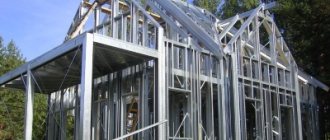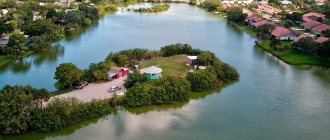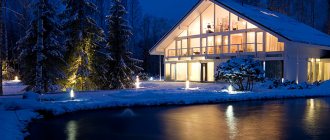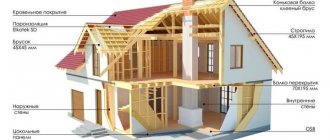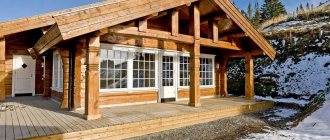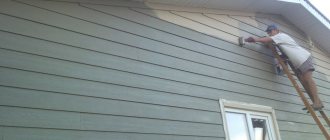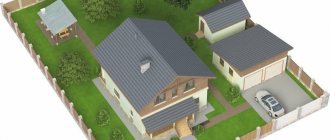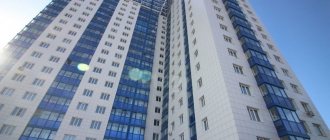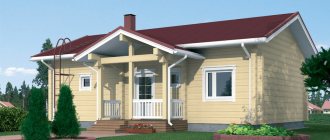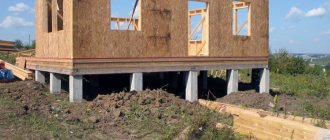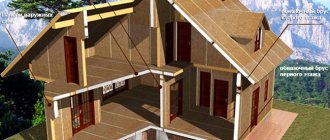A frame house built using Finnish technology has its differences from European, North American or Canadian ones.
The phrase “Finnish house” is also used quite often in Russia and the CIS countries.
Although few people know what it is, because it was previously applied to small panel houses, which, in fact, have nothing to do with real Finnish ones.
Frame houses in Canada are built according to codes, in Russia according to SNIPs, but in Finland there are no such standards.
All solutions are applied individually for each house, they are prescribed in the developed project and after its approval by state supervisory departments, the house can be built using parts and modules manufactured at the factory.
What does the concept mean?
This is a prefabricated residential building, assembled like a building kit from finished products and modules manufactured in a factory.
In order to order such a house, a project is first completed, where all the characteristics of the house are indicated: walls, rooms, floors, roofing and foundation.
And construction kits are already cut using it.
A Finnish frame house is assembled from kits, which can be produced in 4 versions, after which they are delivered to the construction site :
- The “Pre-Cut” kit is formed into a general structure on the site.
- Modules with minimal readiness, assembly is made from ready-made blocks sheathed on the outside, internal communications, partitions and interior finishing are carried out on site.
- House kit - partially sheathed modules with external finishing, with installed windows and doors. They are installed on site on the foundation and assembled in blocks, after which the roof is installed.
- Modular house. In practice, it is used very rarely due to labor-intensive delivery and significant cost.
Note! The second option is the most preferable because it has the lowest cost, approximately 25 -30 thousand rubles. for 1 m2.
The highly economical technology of Finnish frame construction makes it attractive for the construction of cottages, summer houses and industrial premises.
Such an object of 130 m2 costs 250-300 thousand rubles. less than a wooden house of the same area, while the developer can get an energy-efficient, strong and durable “turnkey project” for only 2500-3500 thousand rubles.
Interior decoration: step-by-step instructions
The walls and ceiling in a frame house are usually finished with gypsum board (plasterboard), and then it is painted or wallpaper is glued to it. GCR is good because it does not burn well. In Canada, it is generally prohibited to build frames without gypsum boards due to fire safety requirements. And more and more often we have lining or imitation timber nailed onto the ceiling and painted (I especially like the white color in this place).
After finishing the walls and ceiling, you can pour a concrete screed, finish the floor with tiles or laminate, and then install interior doors. Finnish interior doors are especially good; many people praise them, but their prices are now exorbitant.
Differences between panel rooms in different countries
The first general difference between these houses is that the parts and blocks for them are made at the factory according to an individual design. The foundation is erected on site by the customer, after which the timber frame of the building and the floors of the lower level are mounted on it, after which the house is assembled from ready-made factory products or blocks.
A characteristic feature of wall blocks is that they come from the factory with built-in communications.
During the production process, only processed boards with tenon joints are used for panels . Such connections guarantee the strength of the house and additionally provide protection from precipitation and hurricanes.
In addition, all wooden elements are coated with special compounds to prevent rotting and burning, but at the same time the house remains environmentally friendly, since the treated wood does not emit harmful components into the atmosphere.
Important differences between Finnish houses and Canadian or North American frame buildings:
- The house is always made rectangular with load-bearing walls, which are located along its outer perimeter, and the floor covering covers it, thereby fulfilling the role of an enclosing structure.
Therefore, the corners and joints in such a building are warm, there is no heat loss in these places, and the small load of the walls on the foundation allows the use of a strip foundation, which provides a 30% savings in the construction budget. - As thermal protection, only mineral wool is used; polystyrene foam and other similar insulators are excluded. This allows you to increase the heat and noise protection characteristics and increases fire protection, which guarantees the operational life of the house up to 100 years.
- A subfloor is laid on the lower floors, then the key components are secured to each other using iron brackets.
- In such a wall, the number of double and triple posts is initially minimized, creating technological openings for doors and windows.
- On typical openings up to 140 cm, a separate crossbar, which distributes the loads from the ceiling onto the openings of windows and doors, is not installed, but a solid crossbar is made, from the outside or from the inside, in the upper part of the frame wall.
- Technological openings larger than 140 cm are reinforced with double racks.
- The wall is reinforced with jibs.
- The wall panel assembly is assembled at ground level, covered with a vapor barrier and protected by an external wind shield. After this, the wall is raised, put in place and sheathed.
Important! Such structural solutions simplify the design of the wall, while ensuring uniform distribution of loads on it from the upper floor and the roofing system.
Foundation
In Scandinavia, two types of foundations are mainly used. The first of them, then, is actively promoted by the famous “Vladimir Tallinn”, and with my light hand, it began to be called USHP (insulated Swedish stove). Roughly speaking, this is a huge trough made of high-density foam plastic, into which a thin concrete slab with stiffening ribs is poured, and all communications are immediately laid into this slab, including a heating system with water-heated floors.
The solution is ingenious in its essence and universality of approach. Since one blow kills several birds with one stone.
True, the USP has two drawbacks, the first is associated with the difficulty of erecting in places with a significant slope, the second is the low height of the base (30cm). By the way, it is the latter that is extremely difficult to accept by the Russian mentality.
In these cases, the second type of foundation comes to the rescue. Sometimes it is called a “Finnish insulated slab,” but in essence this is not entirely true, and the type of foundation itself is well known in Russia - “floors on the ground.”
The essence is quite simple, a shallow strip foundation is made with a supporting sole (heel), then there is backfilling with soil, insulation and a reinforced thick screed on top, also with communications embedded in it and a system of water-heated floors.
True, the execution of floors on the ground also has distinctive features from Russian versions.
By the way, what’s interesting is that a very common option is when a house begins to be built as soon as the “tape” and backfill are ready. But the final finishing of the floor (insulation, reinforcement, heated floors and pouring) occurs already when the frame is “under the roof”
I will not dwell in more detail on the description of these types of foundation, since this is the subject of a separate large article.
Pile foundations, strip foundations with overlap on wooden logs are used very rarely. It happens that small “guest” houses or saunas are simply placed on blocks, but even in this case, the approach to the construction of these “support columnar foundations” is more comprehensive and correct than ours.
You can read more about the design of the USP and the Finnish foundation in another article.
Suitable materials
The basis of such house construction is Finnish laminated timber, OSB and fiberboard wall boards, and mineral wool between them. If the technology for the production of slabs and laminated veneer lumber has been maintained, then as a result the developer will receive an excellent building material with a service life of at least 100 years.
Glued laminated timber
Its advantages :
- High strength is ensured by a minimum beam cross-section of 245x100 mm; for seismically active areas and in areas with moving soil, the cross-section is chosen to be larger.
- Complete absence of cracks.
- Very high heat and noise protection characteristics.
- During the natural drying process, the percentage of total shrinkage does not exceed 1%, so the structures are never deformed.
- Absolutely waterproof.
- Biological resistance against rodents and fungal infections.
- High fire resistance.
- Environmental Safety.
- Does not require additional finishing.
Experts attribute the high purchase price to the disadvantages of laminated timber.
Fiberboard
Unlike Scandinavian technology, Finnish technology never uses SIP panels. Walls using Finnish technology are made of multilayers: the outer finishing layer is fiberboard, mineral wool and the layer facing the interior is OSB .
The outer cladding is made of fiberboard slabs of wood fiber structure treated with wax to achieve high moisture resistance. In addition, the strength characteristics of a building material greatly depend on its density, which you need to pay attention to when purchasing this material. The main advantages of fiberboard are :
Affordable price.- It lends itself well to processing without changing its structure.
- Can act as a finishing layer.
- The plates hold all mounting elements inside well: screws and bolts.
- Very high heat and noise protection characteristics.
- Biological resistance against rodents and fungal infections.
- High fire resistance.
Important! During production, building materials are coated with antiseptics, hardeners and compounds that increase hydrophobic properties. According to these indicators, fiberboard is an order of magnitude superior to similar chipboard.
Disadvantages include increased flammability and the presence of formaldehyde resins. Although their percentage in the material is much less than, for example, chipboard and MDF - no more than 3% versus 11-14% for analogues.
OSB
They are made using large wood chips, rectangular in shape 140 mm and up to 0.6 mm thick, laid in 3-4 layers, each layer with a different direction: the outer layers are longitudinal, the inner layers are transverse. Next, they are impregnated with phenolic resins, wax and boric acid and compressed under high pressure.
As a result of this technology, OSB boards receive the following advantages compared to other wall boards used in frame houses:
- High impact resistance.
- Increased elasticity.
- High moisture resistance.
- Increased thermal and noise protection.
- Biological safety, not susceptible to fungal infection.
- Durability and service life are unlimited if the technology is followed.
- They are not subject to shrinkage, which guarantees the rigidity of the wall structure.
- Low cost.
Reference! The density of OSB is approximately equal to the density of wood 650 kg/m3, but there are no voids or delaminations inside it.
Among the disadvantages, experts include the presence of polymer resins for the binding process, although they do not contain toxic phenol. For class E1 boards, the formaldehyde content should not exceed 8 mg/100 g OSB.
Mineral wool
Only basalt-based mineral wool is used
as insulation in Finnish houses .
This material is used to insulate all main surfaces: floors, ceilings, walls and roofing.
Since it is completely fire-resistant and does not decompose during operation, its installation increases the service life of the house by almost 4 times in comparison with Canadian buildings.
Advantages of mineral wool for insulating Finnish houses:
- Density up to 100 kg/m3.
- Plates with a standard size of 0.6 m2 are lightweight, which simplifies installation.
- Minimum shrinkage reaches no more than a fraction of a percent over 50 years.
- Low thermal conductivity, depending on the density 0.040-0.060 W/m*G, if the mats are filled with moisture, the thermal conductivity will increase.
- Frost resistance not lower than F50.
- Vapor permeability is high, the material breathes.
- It is non-flammable, melting of the fibers begins when exposed to T = 1000 C for 2 hours in a row.
- Low cost.
- High noise absorption coefficient from 0.7 to 0.9.
- environmental Safety.
- Biological and chemical stability.
- Service life over 50 years.
- Simple installation technology.
The disadvantages of the material primarily include high hygroscopicity and large volume, which increases the cost of delivering the insulator.
Important! To reduce the level of water absorption, mineral wool is treated with specific water-repellent solutions.
Do-it-yourself frame: step-by-step instructions. Electrical and heating
Now is the time to connect electricity from the pole to your electrical panel (it is better to design and assemble it in advance, and before that get permission to connect a specific amount of kW).
After the house is insulated, but before the finishing stage, it’s time to also start heating. We start with choosing heating fuel (wood, gas, electric, gasoline), a boiler, and then the material for the heating pipes. Recently, heated floors are increasingly being chosen for frame houses instead of heating radiators.
A Canadian wooden house is very warm; it needs to be well insulated once, and then it can even be heated with electricity. Of course, the cost of electric heating will be 3 times more expensive than gas heating, but still less than what you pay in an apartment.
Options for layouts and projects
There are several layout options and designs for such houses, which are especially popular among users:
- A classic Finnish one-story house with a single or gable roof. Finishing materials are wood, the layout includes 2-3 bedrooms, a living room, a dining room, a kitchen, 2 bathrooms, a children's room, a sauna, many windows, 2 entrances, an open terrace and a firebox.
Modern style , which combines classics and modern technologies.
A project with attractive ergonomics and attic levels that increase usable space.Efficient lighting with panoramic windows in the living and dining areas.
Two-story house with covered and open balconies, protected by a veranda. Very compact and comfortable layout: downstairs there is a kitchen, dining room, laundry room, dressing rooms and many other auxiliary rooms. Upstairs there are 2 bedrooms, a guest room and children's rooms, 2 bathrooms and an office.
- High-Tech style combining practicality and functionality. The main feature is huge spacious rooms with a minimum of partitions; zoning is done using furniture and lighting.
In which lines do we use overlap assembly?
Line of bathhouses with a rounded roof “Bukhanochka”:
Modified version of “Loaf” with an entrance in the middle:
Baths with a terrace and a prominent side wall “Bourget”:
Transportable bathhouses with a roof to the ground “Rounded”:
Finnish baths "Suomi":
Large stationary frame-assembled bathhouses according to the “Corner” project:
Inexpensive mobile baths "Quadra":
We hope that the material is presented clearly. If you have any questions, write to us or ask in the VKontakte group, where we answer quite quickly.
Features of the construction process
The technological process for the construction of a traditional Finnish frame house must have the following stages:
- The construction of a shallow strip foundation or columnar foundation, which gives developers significant savings in building materials.
- During the process of pouring the foundation, embedded parts are installed to tie the wall frame.
- After the foundation, the installation of floors for the 1st floor is carried out.
- Next, the subfloor is laid, a frame is prepared under it from beams 245x100 mm and an inter-beam spacing of up to 40 cm. It is covered with plywood of at least 18 mm and the construction of the wall frame begins.
- The walls are built in a lying position on the floor, the base is a 150x50 mm board.
- The frame lock, in a wooden beam, is in addition reinforced with self-tapping screws, and movable joints are also used.
- Then the frame is protected by a wind- and vapor-permeable membrane up to 25 mm.
- Next, the wall is installed vertically and connected to the lower ceiling; the strongest connection is considered to be fixed with studs. The walls are connected to each other by bolts through special holes in the corner bars of the structure.
- If the house is two-story, on the walls of the 1st floor, the interfloor ceiling is strengthened using beams of a smaller section of 245x50 mm and a pitch of up to 35 cm, since this structure experiences less load.
- The subfloor and wall installation are carried out in the same way as the first floor.
- The base for the roof is the upper part of the walls; the rafter beam is taken 150x50 mm for a house without a residential attic.
- The inside of the beams is lined with plywood from 8 to 10 mm.
- Roof rafters are placed on the beams, which are covered with lathing, heat insulation, wind and vapor protection and roofing material.
- The building is finished with a block house or clapboard; a ventilation gap is left between the finishing and the wind protection.
- After this, windows, doors and utility networks are installed.
- Finally, the final finishing of the premises is carried out.
Important! Before installing wooden products, they must be subjected to protective treatment with fire retardants and antiseptics.
Stages of building a house using Finnish technology
- Personal Preposition and Design . Determination of the number and size of rooms, floors, type of materials used and expected load on the skeleton and frame.
- Construction of the foundation . Allow at least two days to build the foundation to gain the necessary strength and stabilize it on the soil cushion.
- Beginning of construction of the zero tier of the frame . Wooden beams must be treated with an antiseptic and laid on a waterproofing layer on top of the foundation. At the corners of the house and at the intersection of walls, the timber is joined groove to groove and reinforced with self-tapping screws and studs for increased reliability.
- Erection of frame walls on the ground and lifting them using a winch. Fastening using grooves and corners, installing beams between walls. Laying out the subfloor, installing joists along the surface and sealing the insulation between them. Wood cladding and tiles will be installed last, in the final part of construction.
General pros and cons
Modern frame houses using Finnish technology are very comfortable due to the use of new innovative building materials. Thanks to this they have the following advantages :
Factory production of building elements.- There are no processes associated with large volumes of water and concrete solution, so the construction site will be clean and the wood will not gain moisture.
- Very high strength of the load-bearing walls, thanks to the special design - the strength of the house is practically no different from that of a stone one.
- High durability of load-bearing structures up to 100 years.
- There are no shrinkage processes; finishing can be done immediately after the walls and roof are erected.
- High speed of construction, for a two-story house no more than 3 months, for a one-story house - less, up to 2.
- Low cost of construction work per 1 m2 of area.
- No heavy expensive construction equipment is required.
Negative aspects can arise if building materials are chosen incorrectly, the frame technology for constructing a house is violated, and the wood is not treated with an antiseptic
Important! In order for a Canadian frame house to serve the period stated by the manufacturer, it must undergo an annual technical inspection to ensure the absence of defects and dampness.
How to close joints when sheathing with lapped boards
A non-trivial question: what to do with the joints? There are several ways to solve this problem. We found a picture where they are clearly presented:
We go the simplest and most aesthetic way - we make rectangular overlays, contrasting in color to the American one. It looks like this:
The least labor-intensive and technologically simple method - no errors, no jambs.
Average prices
The cost of such a house consists of two parts: the cost of the kit and installation. These price indicators depend on the technology of constructing the frame structure, the number of storeys, the building plan and the distance from the road infrastructure.
Average prices for a house with an area of 120 m2, depending on the configuration and type of wood:
- House kit, regular timber - 7,500 rubles/m2, laminated veneer lumber - 22,000 rubles.
- Country house, regular timber - 15,500 rubles/m2, laminated timber - 27,500 rubles.
- Turnkey house, regular timber - 17,800 rubles/m2, laminated timber - 32,000 rubles.
Installation speed
The choice in favor of the Finnish technology of frame house construction is made, first of all, because of the high speed of installation . For comparison, let’s take a log house, the construction of which takes an average of 1.5 years.
Approximately the same amount, taking into account the expectation of shrinkage and the peculiarities of wall laying, is spent on building a brick house.
As for Finnish houses, their installation will take 3-4 months, which means that construction started in the spring can be completed in the coming fall.
Some delays may occur if complex designs are used. It is also important that construction can be carried out in winter .
Photo
In the photo below you can see what Finnish houses look like:
Life time
Who doesn’t want a house built with their own hands to be passed down from generation to generation? Unfortunately, not every technology can boast of durability, which cannot be said about Scandinavian houses.
Opinions regarding the service life of frame houses are different - some say that after 30 years they become unsuitable for living, others, on the contrary, are sure that grandchildren and even great-grandchildren will live happily in a Finnish house.
Instead of guessing “from the tea leaves,” let’s turn to Russian state standards, and according to Gosstroy documents, frame buildings are given a service life of 75 years.
Ventilated facade
The presence of a ventilation gap ensures long-term preservation of wooden cladding. Moisture does not accumulate and does not cause swelling or warping of wood.
The facade is mounted on 100x25 mm slats. For a house height of more than 7 m, the gap is 50 mm. There is free access for air circulation at the top and bottom of the casing.
The boards are placed vertically (classic Scandinavian version), horizontally or in combination. The main elements are covered with flashings. They are attached directly to the sheathing, bypassing the façade board. This technique is used to avoid deformations and cracks in the finish due to fluctuations in humidity.
When fastening boards vertically, they sometimes do without strips. It is important to maintain a gap between the elements of no more than 8 mm, otherwise the damaging effects of ultraviolet radiation and precipitation on the MDVP cannot be ruled out.
Horizontal boards are secured in their lower part, nailed to the sheathing with galvanized nails. The profiles are joined using a tongue-and-groove lock, the planed smooth elements are laid with an overlap of at least 20 mm.
Order Finnish frame construction from us
By contacting us, you can get a lot of advantages:
- Creation of not a standard, but a modified project according to your criteria and requirements. Personalization and customization.
- Adequate cost of work.
- Fast execution.
- Using only high-quality materials and original components.
- Modern construction techniques.
- Full reporting at any stage.
- Compliance with all legal standards in our country, in particular, the requirements of SNiP.
Is it possible to build in winter?
When using traditional building materials and technologies, there is often no need to talk about construction work in winter.
Meanwhile, this does not apply to Finnish houses, for which there are no restrictions on air temperature.
Moreover, it is even cheaper to build frame houses in winter, since significant discounts on lumber are offered during this period .
It is also worth noting that during severe frosts there is no precipitation, which means minimal humidity, which harms lumber. If in summer the average monthly precipitation is 735 mm, then in winter it is usually no more than 200 mm.
Another advantage of building in winter is the absence of shrinkage, although this does not threaten frame houses, in principle.
As for the disadvantages of winter construction, they also exist . In particular, the construction process is difficult due to the fact that builders are simply freezing, so their physical activity is significantly reduced.
But the cost of work in the autumn-winter period is significantly reduced due to a shortage of orders, and this is also a significant saving.
Insulation
Relevant for our country. In many regions, the temperature during the peak phase drops to catastrophic levels. Therefore, it is worth taking care of insulation even at the stage of analyzing the plan.
For this task you will need a special multi-layer coating that can combine a lot of functions. And the Scandinavian method has this. It prevents the penetration of cold, protects against temperature changes, and prevents cold bridges from appearing due to its continuous structure. This is a porous material that allows air to penetrate, as well as the outflow of moisture if it gets inside. This is often the main feature. Indeed, in the American or Canadian version, rigid boards are used that retain moisture inside the insulation. This means they contribute to potential rotting.
Almost every frame house in Finland is designed this way; the features of the insulating coating include such elements as:
- Facade board, which has special gaps for free movement of air inside.
- Inner hard layer.
- Grate with insulation – mineral ecowool. This is a cellulose material that is completely natural in origin. It does not emit any harmful chemical fumes and is absolutely safe for residents.
Architectural solution
Many people associate the Scandinavian style with a low base, small glass area, wooden paneling and a lack of architectural decoration. The development of construction technologies and the production of new materials with high thermal insulation properties have made it possible to change this established opinion.
The Finnish house today is a tradition of wooden architecture in a modern design. As before, the facades of the buildings remain strict and laconic; natural wood trim prevails. The roof is usually gable or divided into two slopes located at different heights. The use of load-bearing trusses resting on the external walls gives freedom of layout of the internal space.
The base has noticeably grown. Now, at the request of the developer, its height is 60 cm or more. Panoramic glazing is often used, which, thanks to modern technologies, effectively retains heat inside the house.
Scandinavian style is characterized by a lack of embellishment, strict geometry, and thoughtful detail. A sauna or garage is often blocked from the main building. The cost-effectiveness of such a solution is obvious - due to the common parts of the foundation, wall, roof and communications, the costs of constructing additional premises are reduced.
Wood paneling is the most common exterior finish of a Finnish house. The facade is faced with vertical or horizontal boards, covering them with opaque paints.
This preserves the wood's resistance to natural factors.
In Finland they use a special technique for processing finishing boards - they use special planing to give the surface a fleecy appearance. Lumber, having absorbed a large amount of paint, does not rot and does not require repair for many years.
Natural supply ventilation
- It is best to carry out installation before finishing the premises, right during construction. If the valve is located behind the heating radiator, it must be temporarily removed and the location of future ventilation must be marked with a marker.
- A hole is made for the ventilation duct.
- A ventilation pipe with insulation is installed into the resulting channel.
- The valve body should not touch the pipe, so it can be attached using foam. The body, like the pipe, can be insulated or a sound absorber can be put on.
- A protective grille is placed on the outside of the ventilation pipe, and a special cover on the inside.
If, when choosing a project for your future home, you chose Finnish frame houses, the construction will be durable and reliable, and with the right choice of materials it will save a significant part of the budget.
Communications
The most current choice for a heating system is a warm floor. Of course, the water type. The layout usually involves a separate room for the boiler room. If radiators are installed, then only on the second floors. Where to install a heated floor is already quite problematic.
On the other hand, if the house is small, then you can easily get by with convectors alone. Especially in warmer regions of the country.
Electrical wiring is installed only internally. Fortunately for wooden hollow walls this is not a problem. There is no need to ditch; the route for the electrical circuit is planned in advance in the design. But the sewer system can be almost any kind. From the central canal, from a well that goes directly into groundwater.
